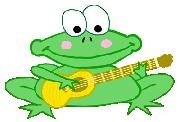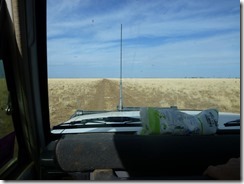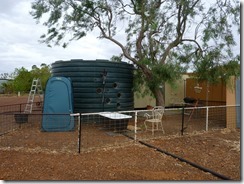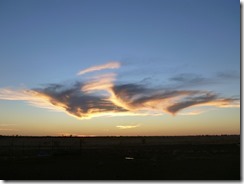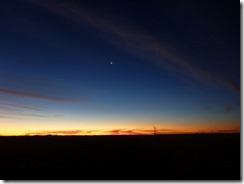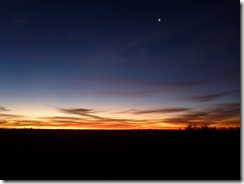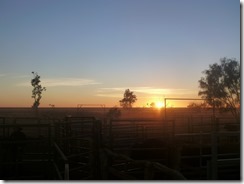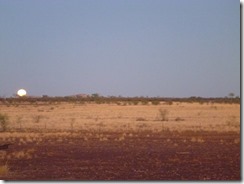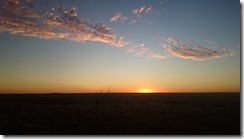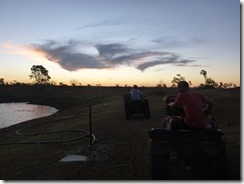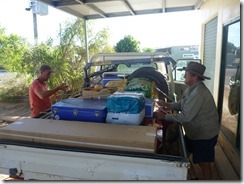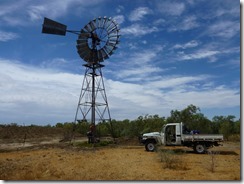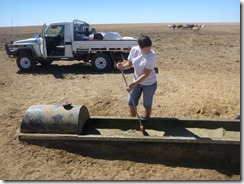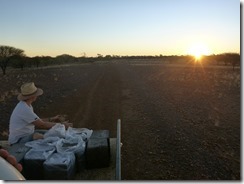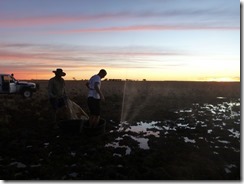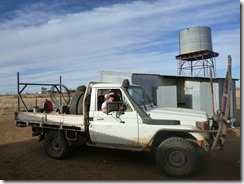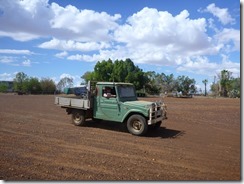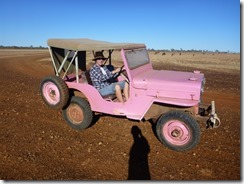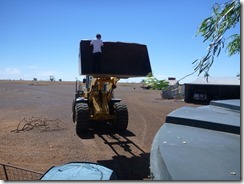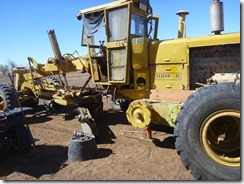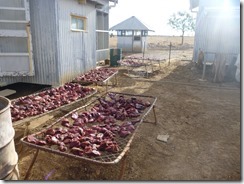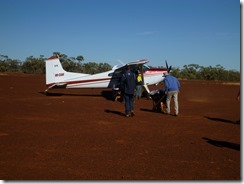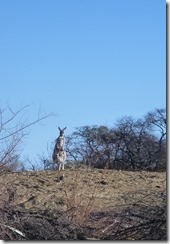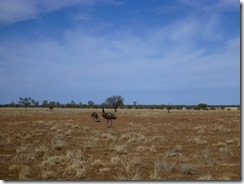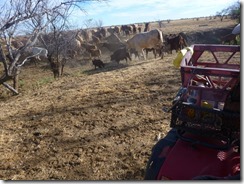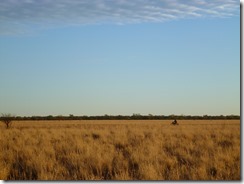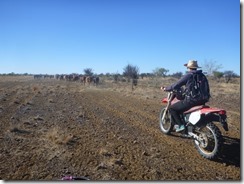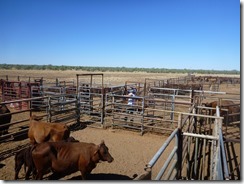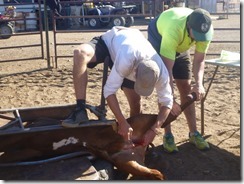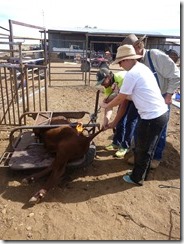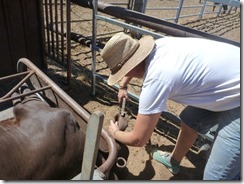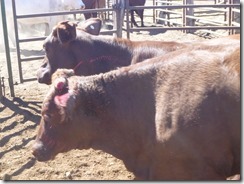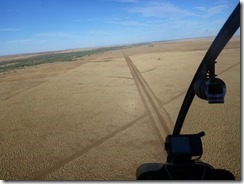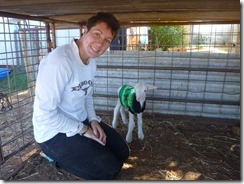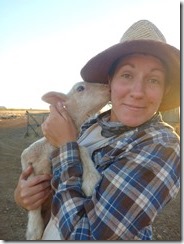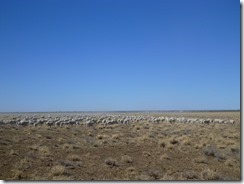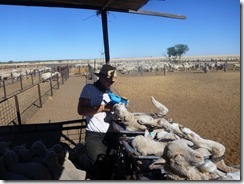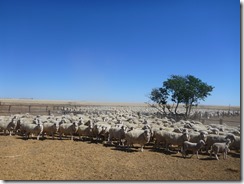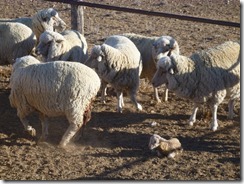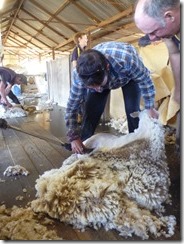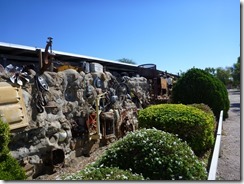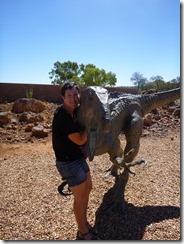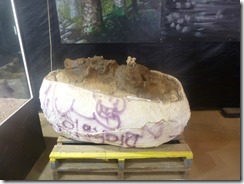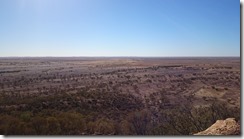
This month was full of new things for me… first of all, Farewell is about 100 km away from the town of Winton, half of it on gravel road with dips and grids. No problem at all with driving 80-100 km/hour on this kind of roads down here!
Driving through the paddocks
I had already an experience in Winton, where I spent the worst day of my trip 4 years ago, when Lily (my ford falcon) got bogged while camping near the river…(read here – in French, sorry…) I hoped to make better memories this time!
Farewell is the main station, about 27 000 acres, where the house is. Unfortunately for Jan and Rob, their big house burned down last October, leaving them only a cabin to live in. They made the best out of it, bought another cabin for living room, office and a spare room. They also made a beautiful guest room out of a water tank! They cut a door on the side, poured concrete for the floor, furnished it with a bed, table, cupboards, air-conditioning, cut rounds on a side to make windows with salad bowls, and here it was! A beautiful bedroom! We loved staying inside it, it made our outback experience even better!
Our tank-room, the outdoor bath tub and toilet
We were getting up with the sun in the morning usually (sometimes a little bit before) and going to bed not long after dark… let’s say it, we slept a lot! (day light way roughly from 6:30 am to 6:30 pm) And we enjoyed watching a lot of sunsets and sunrises!
Sunrises, sunsets, moonrises, moonsets… everyday!
Narangie, the other property from Jan and Rob, is about 33 000 acres, and located 60 km of Winton. (a little bit closer!)
We stayed there from the 16th of April to the 16th of May.
WATER
The whole area is in a drought for about 3 years now. There hasn’t been a proper rain to flood the country in all this time. It is crazy when we think about it. People on stations depend on rain for the obvious reason of water resource : the water we drink is out of a rain water tank (this is only for drinking) and all the rest of the water is pumped out of a dam (washing clothes or dishes, cleaning, cooking, boiling, showering, teeth brushing…). The water is running clear but is a bit dusty in general. The dams are filled with rain water as well, so it needs to rain sometimes!
The rain is also of course needed to run the property: cattle and sheep is here, they do need to drink, so there are a lot of different dams, where the water is pumped to water tanks to have the troughs full at all time. But rain is needed to make the grass grow again! The grass is yellow in the paddocks, and we can all guess that the cattle or the sheep would do better with green grass!
But we also learned that not any rain is good rain: on a dry land like now, it is needed to have a good soaking rain, but not a little rain because it would just wash out the grass (the roots are weak) and the animals would not have anything to eat anymore.
When it happened to rain properly, Jan and Rob would be stuck at home because all the creeks would be flooded and impossible to drive through. It could be up to 6 weeks!
The rain is one of the most common topic when you meet other people in the area.
When people told me about crossing a creek in a paddock I did expect some water or wetland… well no, it is a ditch, dry like everything else around, but with a lot of trees. So I know now that there is a creek when there are trees!
Driving around at the house dam with the dogs in the evening
SUPPLIES
Living 100km away from town (with a small supermarket) and 6 hours away from a city, people out here need to manage their supplies a little bit differently to what we are used to. So the groceries shopping happens once a week or so, and then they store it until needed. To store it, houses are usually equipped with a cold room. Freezers are also a really important equipment! They need to have enough food in case they happen to be stuck on their property because of the rain!
Shopping day = picking up the orders!
About the fuel: when living so far away, with a lot of different vehicles or equipment needing fuel to work, you do need to have some fuel available! They have on the station thousands of liters of fuel and diesel. After mustering a paddock, you might already have your motorbike out of fuel!
The cars in the outback have sub-tanks. This is the first time I have seen it. there is the normal fuel tank, and then another one that can be used at anytime. Pretty useful for longer trips when we are out in the middle of nowhere, with a few hundreds of kilometers between 2 towns…
WORK AROUND THE STATION
The daily work on the station is mainly maintenance (out of cattle and sheep work) : everyday there will be a pump to fill with fuel that it can fill the water tanks and troughs from the dams, a fence to fix or straighten, a road to repair, some lick and salt to put out for the animals, a broken down vehicle to repair, a flat tyre to replace, a trough to clean, a roof sheet to screw back on properly, a leaking pipe to fix… and so much more! When you leave for a water or lick run (meaning going out checking the water supplies for the cattle or sheep in every paddock), you never know when you come back!
Fixing the pipe of one windmill
Cleaning a trough
Lick run for the sheep
Changing a pipe in a paddock
There is always something to do. And the shed is full of everything! We could fix anything with all the spare parts and old parts of all different equipment and all the tools… It was a huge shed, with seriously everything.
Then there are the “toys”. Some of them are working toys, some are just for fun toys… starting from an old ford falcon, a jeep from the fifties, 3 Utes, a truck (for cattle, bales of hay…), a loader, a tractor, 4 motorbikes, 3 quad-bikes, 1 hovercraft, 1 grader, and so much more… We had the opportunity to have a go in a few of them!
The old Toyota, used for fencing – Old Daihatsu, used for spraying
Old ford Falcon Ute – Old Jeep
In the loader… well, in the bucket!
The grader
When the owner of the station needs someone to help with some jobs (cattle work, sheep work, maintenance, sheering…) people come out to live at the station, so they provide accommodation and food on the station plus the wage! This is a different kind of life out here…
WILDLIFE
The wildlife here is kangaroos, dingos (wild dogs), wild pigs and eagle hawks. Let’s not count all the birds, the emus, the spiders and the snakes, but only the harmful ones for the cattle and sheep. The dingos kill and eat the sheep. The eagle hawks kill the lambs and eat them. The wild pigs eat the grass, damage the dams, and could eat some lambs. The kangaroos eat the grass and drink the water. All these animals are not good for the stations, so there are action to try to get rid of them : shooting, baiting, trapping, or more fencing (cluster fences)… this is not easy and there will be always these predators around, making it harder on the stations.
Meat for the baiting, unfreezing process, and loading the poisoned meat on the plane
Small snake (black headed python)– A Kangaroo mum and her joey
Emus
The prickly trees could be considered as wildlife because the prickles attack you all the time! Whether you drive, walk or sit, prickles are everywhere! The trees were imported from South Africa and got out of control in Australia. The prickles are a few centimeters long and really strong, so they can get into the skin like needles (or in the tyres). There were always some to be removed from our hands.
CATTLE WORK
The cattle has to be mustered, walked to the yards, sprayed, drafted, branded, marked, weaned, fed, and then sold or walked back to the paddock about 2 times a year.
We helped to muster a few paddocks, it was pretty hard to know where to go sometimes because we could not see the others and because we did not have the radio communication. To muster, we went on motorbikes and quad-bikes, tried to get all the cattle together to one corner of the paddock, and push them through a gate to the laneway. The laneway is a lane that starts from the furthest paddock, going along every paddock and ends a the yards. We “just” have to follow and push the cattle to make sure they keep walking all the way and don’t go back to their paddock. The laneway was pretty long, it took about 2,5 to 3 hours to do all this way.
Mustering on the quad-bike and on the motorbike
Tailing the cattle in the laneway
Once we had an “adventure” in the laneway: One gate was closed in the middle, so the cattle stopped. We kept pushing because we did not see that the gate was closed… so the cattle got scared and ran backwards, straight on to us… There were a couple of bulls in the mob, I was a scared to drive back and try to stop them, chased by about 100 cows and bulls… Well, we lost about an hour that day!
When all the cattle is in the yards, we can draft them. The cows and bulls in one yard, the weaners in another one, the calves in the last. The calves, if big enough, are marked (a cut in the ear), tagged (a tag in the other ear), branded (marked with a glowing iron on their back), their horns are tipped and their balls are cut (if they are boys).
Drafting
Balls cutting – Branding
Ear marking – Horns tipped
The weaners are older calves, a bit like teenagers. They are kept in the yards for a few days or a week, to make them independent from their mothers. Then the cows can have a new calf. If they are not weaned, they will keep eating the milk from their mums and not allow them to have other calves.
The rest of the cattle is walked back the same day to the paddock, through the same laneway. One person has to be one the front of the cattle, to avoid them to run to fast. We had to make sure they walked. It was a long way to walk, without much water, and the days were relatively hot (well, for me it was super hot, but for the locals it was just alright…)
At the front of the mob
Walking the weaners to the paddock
I had a chance to sit in the chopper while mustering at Narangie. A part of the mustering was done by a subcontractor with chopper because the terrain was too tricky: trees and channels make it hard to muster from the ground.
Leaving the ground…
The outback from the sky
Mustering from the sky
SHEEP WORK
The first thing I learned with sheep, was the mis-mothering of the lambs. If someone happens to drive next to an ewe (female sheep) with a new born lamb (or a few days old) the ewe will start running away as fast as she can, and sometimes she could just leave her lamb behind. So we have to be very careful every time we approach some sheep and watch out for the ewes, check that they leave with their lambs. The lambs would die on their own pretty fast!
The 3rd of May, we were out on a lick run in a sheep paddock, it was sunset time, and there, next to the road, there was a little lamb, few days old, sitting and waiting. His mother had taken off somewhere, maybe scared of something (animal or other) or she just left him. Unfortunately, this happens in sheep world, to have some really bad mums. But it is really reassuring when you see some ewes turning around all time, waiting for their lambs to be with them. So we could not leave this little lamb out in the dark, he would have probably not survived the night. We took him home, and fed him everyday. His name is Little Alex. He even got to wear one of the dog’s jacket at night because it was getting a bit chili. He had to be fed a lot, he was pretty hungry! He is a happy lamb, I went with him everyday for a little run and exploration everyday, trying to make him discover the grass he could chew on, or putting his nose in water he could drink if he was thirsty… he was happy and jumping around, or trying to at least! He made me baa and recognized me after a while! He was a cute little lamb. Unfortunately we left and we could not take him with us to New Zealand…
My little lamb…
For the sheep work, we had to muster, walk to the yards, draft, mark, tag, ring… I felt a little bit more comfortable with the sheep as they were not as big and heavy as the cows.
So we went out mustering. When we had the tail of the mob, Rob saw a ewe with a really small lamb, he wanted to cut them off that they do not have to follow the mob, they could stay in the paddock. But the ewe was determined to follow the mob! She left her lamb behind and ran to the mob. With Alex, we went back to find him and when we did, he started to run away… He was tripping, falling, getting up, running more… he made me run in circles a few times, until I caught him. Alex took him on the quad-bike and we kept going. We put him in the yards when we eventually got there, that he could try to find his mum again.
Tailing the mob – Putting the baby in the yards to find his mum
When all the sheep were in the yard, we had to pen them in a chain of smaller pens, to push them to the drafting race. The lambs, ewes, rams were separated. We took the lambs to mark them, tag them and ring them. The ear marking was making the lambs bleed a bit, as well as the horns cutting. rings were placed around their tail and around the boys balls. The ring will cut the balls and tails after a while. The tails were cut (called docking) to avoid the poo to accumulate on their bottoms. It decreases the risk of blowfly maggots.
When the lambs are processed, they go back to their mums. We keep them all in the yards for a bit, that we are sure that they will mother up. Then later, we open the gate to a small paddock (the holding paddock) where we try to keep them all together, in case there are still some lonely lambs.
Ear tagging – trapped in the middle of lambs!
Pushing the sheep to the backyard
While we were there, we processed about a thousand lambs. When we opened the gate to the holding paddock of the last mob we had, we saw a tiny fresh lamb sitting on the dirt in the yard. His mum took of. We took the little lamb (still wet) and put him outside in the paddock, hoping that his mum would come back to take him. What she probably did, because later that day the lamb was not there anymore.
A new born in the yards – The really fresh new born
We did not stay until sheering time but I had a chance to try myself in a neighbor’s station where we went to get some hay! The sheerer explain to me what to do, put the trimmer in my had and hop! I was sheering! That was pretty surprising!
Sheering a sheep
TOURISM
Jan brought us to the Age of Dinosaurs because a lot of Dinosaur’s bones have been discovered in the Winton shire in the last 15 years. They are really busy with digging the bones out, cleaning them/ preparing them and analyzing them. We could visit the lab where they prepare the bones, touch a bone, and get a lot of explanation about the lives of the found Dinosaurs.
We went to the musical fence (that did not change in 4 years) and Arno’s wall in town (where every kind of engine or part of vehicles can be found in the stone and concrete wall).
Arno’s wall
Hug with a dinosaur
The bone we could touch
The view from the top of the hill
